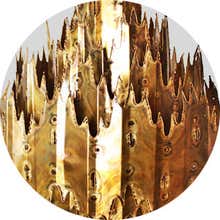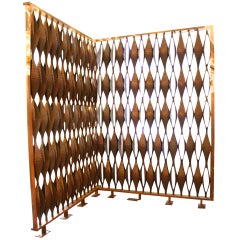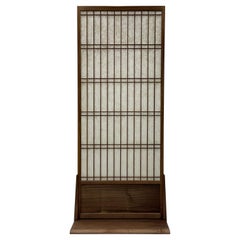Brutalist Furniture and Design

The term brutalism — which derives from the French word brut, meaning “raw” — was coined to describe an architectural style that emerged in the 1950s featuring monumental buildings, usually made of unornamented concrete, whose design was meant to project an air of strength and solidity. Le Corbusier essentially created the brutalist style; its best-known iterations in the United States are the Marcel Breuer–designed Whitney Museum of American Art and Paul Rudolph's Yale Art and Architecture Building.
Lately, the word “brutalist” has been adopted by the realms of design and the decorative arts to refer to cabinets, tables, and accessory pieces such as mirror frames and lighting that are made of rougher, deeply textured metals and other materials that are the visual and palpable antithesis of the sleek, smooth and suave. Brutalist design encompasses that which is crafted, hewn and worked by hand — an aesthetic rebuke (or, at least, a counterpoint) to furniture that is created using 21st-century materials and technology.
Paul Evans is Exhibit A for brutalist design. His Sculpture Front cabinets laced with high-relief patinated steel mounts have become collector's items nonpareil, while the chairs and tables in his later Cityscape series and Sculpted Bronze series are perhaps the most expressive, attention-grabbing pieces in modern American design. Other exemplars of brutalist design are Silas Seandel, the idiosyncratic New York furniture designer and sculptor whose works in metal — in particular his tables — have a kind of brawny lyricism, and Curtis Jere, a nom-de-trade for the California team of Curtis Freiler and Jerry Fels, the bold makers of expressive scorched and sheared copper and brass mirror frames and wall-mounted sculptures.
The names of other brutalist designers are, so far, unknown to history. The furniture and sculptures on 1stDibs lend unique, eccentric, human notes to an art and design collection.
1960s American Mid-Century Modern Vintage Brutalist Furniture and Design
Bronze
2010s American Brutalist Furniture and Design
Walnut
1970s American Vintage Brutalist Furniture and Design
Mahogany, Glass
Late 19th Century French Arts and Crafts Antique Brutalist Furniture and Design
Bronze
20th Century Unknown Brutalist Furniture and Design
Wrought Iron
1970s American Vintage Brutalist Furniture and Design
Aluminum
Late 20th Century German Mid-Century Modern Brutalist Furniture and Design
Bronze
20th Century French Mid-Century Modern Brutalist Furniture and Design
Bronze
1960s European Brutalist Vintage Brutalist Furniture and Design
Bronze
20th Century American Brutalist Furniture and Design
Iron
Mid-20th Century Brutalist Furniture and Design
Cast Stone
Late 19th Century Italian Rococo Antique Brutalist Furniture and Design
Wood
Early 20th Century American Beaux Arts Brutalist Furniture and Design
Iron
Read More
This Lavish 18th-Century Chimneypiece Comes from a Historic Scottish Estate
The exceptionally crafted mantel was saved despite the home’s regrettable demise.
A Pair of Monumental Stone Tigers Protect and Guide Wandering Souls
The Qing dynasty beasts honored the dead and warned off malicious spirits.
Andrés Monnier’s Stone Tub Makes Bathing a Rite of Renewal
The dramatic piece transforms a daily scrub into an act of communion with the elements.
Meet the Siblings behind the Exquisite Outdoor Furniture of McKinnon and Harris
Anne and Will Massie apply the lessons of the past to create alfresco pieces as timeless as the traditions that inspire them.
35 Wondrous Outdoor Dining Spaces
Eating meals alfresco is one of the great pleasures of warm weather, and a beautifully appointed space only heightens the experience. Get inspired by these delectable dining areas as you think about creating your own outdoor oasis.
In These Chic Homes, Indoors and Outdoors Freely Mingle
Through potted plants, garden furniture, nature-inspired art and architectural apertures, designers are bringing the outside in.
24 Perfect Patios with Fire Pits and Fireplaces
In these stylish spaces, the outdoor season extends year round.
40 Spectacular Spaces Warmed by Fireplaces
As the days grow colder, the desire to gather around the fire grows stronger. Take a peek at these well-appointed rooms featuring extraordinary sculptural and historic fireplaces.


